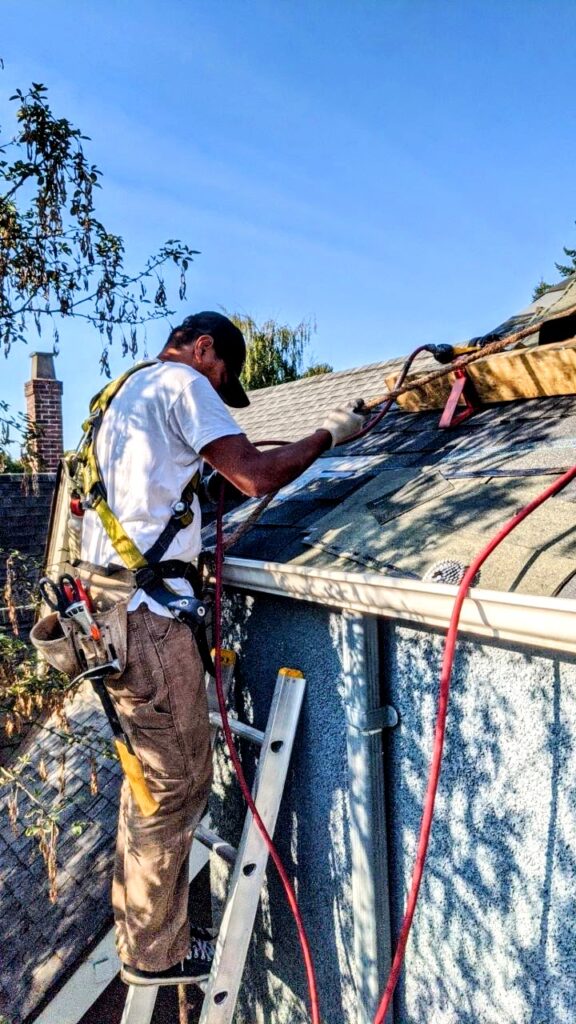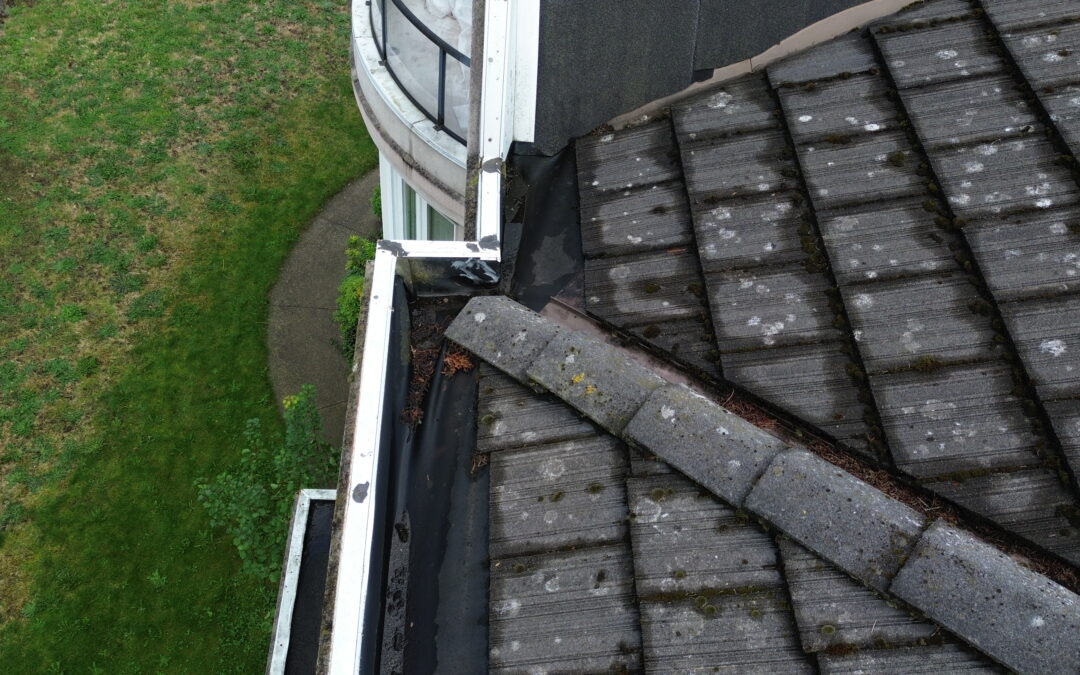Proper rain gutter installation is vital for protecting your home from water damage. In Vancouver’s rainy climate, well-installed gutters and downspouts channel rainwater away from your home’s foundation, siding, and landscaping, preventing erosion, leaks, and costly repairs.
However, mistakes during installation can lead to issues like water damage, leaks, and frequent roof gutter repairs. Common errors include incorrect slope, improper placement of downspouts, and using the wrong gutter size.
Understanding these pitfalls is essential to ensure your roof gutters function effectively. Let’s explore the top 7 mistakes that can cost homeowners significantly and how to avoid them.
Incorrect Slope During Rain Gutter Installation
One of the most common mistakes during rain gutter installation is getting the slope wrong. While it may not seem like a big deal, an improper slope can lead to serious problems. If the slope is too flat, rainwater will pool inside the gutters, causing debris to build up and clog the system. On the other hand, if the slope is too steep, the water might rush out too quickly, leading to splashing and potential damage to your foundation.
A properly installed gutter should have a slight slope—about 1/4 inch for every 10 feet—toward the downspouts. This ensures smooth water flow, preventing backups and reducing the need for frequent roof gutter repair. Adding gutter guards can also help minimize clogs by keeping out leaves and debris, which is especially useful in Vancouver, where wet weather is frequent.
By ensuring the right slope during installation, you can avoid costly repairs and keep your gutters functioning efficiently for years.
Using the Wrong Gutter Size
Choosing the right size for gutters might seem like a simple task, but it’s easy to get wrong. Many homeowners don’t realize that rain gutter installation isn’t a one-size-fits-all process. Using gutters that are too small for your roof can lead to overflows during heavy rain, which is common in places like Vancouver. This overflow can damage your foundation, and siding, and even cause water to seep into your basement.
The correct gutter size depends on factors such as the roof’s surface area and the typical rainfall in your region. For example, in areas with frequent downpours, a larger gutter—typically 6 inches wide—might be necessary to handle the water load. Pairing these larger gutters with well-placed downspouts ensures water flows smoothly without spilling over.
Proper sizing also reduces the chances of needing frequent roof gutter repair due to strain on the system. Ensuring your gutters are the right size from the start can save you time, money, and the hassle of constant maintenance.
Poor Placement of Downspouts
Even with correctly sized gutters, poor placement of downspouts can lead to major issues. The purpose of downspouts is to direct rainwater away from your home’s foundation. When they aren’t properly positioned or if there aren’t enough of them, water can pool around the base of your home, increasing the risk of foundation damage, soil erosion, and basement flooding.
A common mistake during rain gutter installation is placing downspouts too far apart. Ideally, there should be a downspout every 30 to 40 feet to ensure proper drainage. Additionally, the water exiting the downspout should be directed at least five feet away from the house to prevent any seepage into the foundation.
Installing extensions or splash blocks at the base of downspouts can further help guide water away from your home, reducing the chances of needing roof gutter repair later. Proper placement and spacing of downspouts are key to ensuring your entire gutter system works efficiently, especially in areas with heavy rainfall like Vancouver.
Not Sealing Joints Properly
Failing to properly seal the joints during rain gutter installation is a common mistake that can lead to serious problems over time. Joints are the connection points where different sections of gutters meet, and if they aren’t sealed correctly, water can leak through. These leaks may seem minor at first, but over time, they can cause water to drip down walls, stain siding, and even damage the foundation.
In regions like Vancouver, where frequent rainfall is expected, poorly sealed joints can lead to constant leaks and eventually require costly roof gutter repair. To avoid this, roofers should use high-quality sealants designed for outdoor use. Ensuring the surface is clean and dry before applying the sealant can also improve the longevity of the joint.
Regular inspections are crucial, especially after heavy storms. If you spot any leaks or notice dripping at the joints, it’s important to get them resealed immediately. Properly sealed joints will keep your gutters working efficiently and help you avoid unnecessary repairs.
Ignoring Roof Gutter Repairs Before Installation
Overlooking necessary roof gutter repairs before starting a new rain gutter installation is a mistake that can cause future headaches. If the existing roof gutters are damaged, corroded, or misaligned, they can undermine the performance of the newly installed system. Imagine investing in new gutters only to face leaks or poor drainage because the underlying structure wasn’t properly fixed.
Before installing new gutters, it’s important to inspect the roofline, fascia boards, and any existing gutter sections. If there are signs of rot, rust, or cracks, these should be repaired or replaced first. Skipping this step can result in water damage, increased maintenance, and the need for repeated roof gutter repair.
By addressing repairs beforehand, you ensure the new gutters and downspouts function effectively and last longer, saving you time and money in the long run. Proper preparation is key to a successful, long-lasting gutter system, especially in regions like Vancouver, where consistent rainfall puts gutters to the test.
Skipping the Installation of Gutter Guards
Another common mistake during rain gutter installation is skipping the installation of gutter guards. Without gutter guards, debris like leaves, twigs, and dirt can easily build up in the gutters, leading to frequent clogs. Over time, these blockages can cause water to overflow, damaging both the gutter system and your home’s foundation.
In places like Vancouver, where trees are abundant and rainfall is heavy, clogged gutters are a frequent problem. Adding gutter guards helps keep out debris while allowing water to flow smoothly through the system and into the downspouts. This reduces the need for regular cleaning and helps prevent unnecessary roof gutter repairs caused by overflow or sagging gutters.
While installing gutter guards may add to the upfront cost, it’s a smart investment that can save you money in the long term. By reducing maintenance and minimizing the risk of clogs, gutter guards help your entire gutter system work efficiently, even in challenging weather conditions.

Not Accounting for Thermal Expansion
Overlooking thermal expansion during rain gutter installation is a mistake that can lead to long-term issues. Gutters are often exposed to extreme weather changes, especially in areas like Vancouver, where temperatures can vary throughout the year. As a result, gutters expand in the heat and contract in the cold. If this natural movement isn’t considered during installation, the gutters can warp, crack, or even detach from the roof.
To prevent this, roofers should leave small gaps at the joints or use special connectors that allow for expansion and contraction. Additionally, flexible brackets can help secure the gutters without restricting their movement. Skipping these steps can increase the likelihood of damage, leading to frequent roof gutter repair.
By accounting for thermal expansion, you can extend the lifespan of your gutter system and avoid unnecessary costs. A properly installed system will handle weather changes with ease, ensuring your gutters and downspouts remain in top condition for years to come.
CONCLUSION
Proper rain gutter installation is crucial to protecting your home from water damage, especially in a rainy city like Vancouver. Avoiding common mistakes such as incorrect slope, poor downspout placement, using the wrong gutter size, and ignoring necessary roof gutter repairs can save you from costly problems in the future. Taking the extra step to install gutter guards and account for thermal expansion ensures your gutters remain efficient and durable for years.If you want to learn more about why rain gutter installation is so important and when you should consider replacing your gutters and downspouts, check out this guide on rain gutter installation. Hiring experienced professionals can make all the difference. A well-installed system not only protects your home but also reduces maintenance and repair costs. If you’re looking for expert roofing services that get it right the first time, reach out to a trusted roofing company today! Proper care now means fewer worries later.

